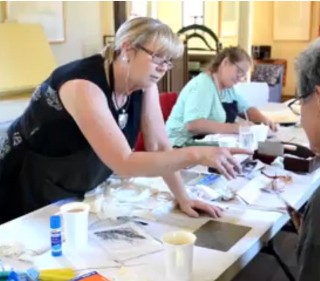Fiona O’Neill, painter talks to Catherine Pilgrim, lithographer about her methods, her project about Buda House and the usefulness of deadlines.
FIONA O’NEILL – Hello Catherine I’d like to welcome you to my studio for the interview for Arts Open – I’d like to ask you about your studio practice … Do you work daily on your arts practice, or when time allows you in the work / life commitment?
CATHERINE PILGRIM – I like to think I work differently … While I don’t necessarily have time in my studio everyday when I’m working towards an exhibition I’ll certainly have my mind ticking around the project as often as is humanly possible.
FO – And if you have a deadline do you find that helps to enable you to focus and achieve more, or do you manage to continue to work regardless of deadlines?
CP – I find deadlines actually very useful things.
FO – So do I! (they both laugh)
CP – I think a deadline helps give me some structure, it helps me to focus, it gives me an end point, and then I can create my own freedom I think, within a deadline to create work.
FO – And how do you go about producing your images? Your drawings, your lithographs?
CP – It depends which medium I’m working with. At the moment I work kind of between photographic and drawn images. I’ve worked with the camera as a compositional tool for a long time, and I often make a photographic image into a lithographic image. The lithographic images are very very slow to make, and for example a few years ago I did a whole series of work based on fruit and vegetables, and there is no way I could have spent the minimum of three weeks I spent drawing each object without the subjects…
FO – Perishing?
CP – Yes, deteriorating, so all sorts of restrictions like that when you work on something quite slowly.
And the photographic element … there have been times when I’ve worked quite a bit with photography and at the moment I’m working out ways I can incorporate both the photographic and the drawn, and I’m thinking about that quite a bit for the next show that I’m doing.
FO – And how do you manage to do that? Sort of layering? Or…?
CP – Well yes, and layering of photographic images is something I’ve done a lot in the past, and what I’m investigating right now, and who knows if this idea will evolve into the work or if it will lead to a dead end, I don’t know, but I’m looking at the idea of perhaps layering a drawn image over a photographic image – and the photographic imagery I’m working with at the moment is almost totally abstract.
FO – Oh that’s interesting… It’s almost a total contrast to the incredibly meticulous and very fine work that I’ve seen of yours.
CP – I’m interested in looking at ways of incorporating a little bit more colour into the work and making abstract photographic images is one method I’m finding quite exciting.
FO – Well yes, it’s interesting because it’s a total contrast, a juxtaposition of very fine detailed to something colourful, abstract … so, should be interesting.
CP – Yes, I’m working with a whole lot of material from Buda Historic House at the moment … Historic Home and Garden I should say. It is…
FO – It’s beautiful.
CP – Yes it is, and it’s lovely that its called a home and not a house, because it was actually a home to a family, and that is its emphasis, and the creativity that came out of that family is what makes it interesting. I’ve been spending a lot of time at Buda investigating the Levinys and what they did, and just the lusciousness and the richness of the objects and the stories that are available throughout the house. And Buda does have this amazing, amazing collection of objects, which are being cared for.
Then there are little things like the technology shifting so quickly. The difference between the way the Levinys lived from the beginning of their time there in the 1860’s to when Hilda, the last surviving daughter died over a hundred years later, and then in contrast to now – is quite remarkable… for example there are still very old fashioned flush toilets at Buda, and an old well pump. There was no such thing as a computer or a mobile phone when the Leviny children were growing up.
FO – Well that’s wonderful for children who have no idea about the old –
CP & FO [together] – Pull the chain! (both laugh)
FO – It’s wonderful that things like pumping water are part and parcel of an everyday occurrence how everyone lived in the past. Now tell me about the exhibition you have coming up in association with Buda…
CP – Yes I’m working towards an exhibition based on this time I’m spending at Buda, and the thing I’m investigating right now is this idea of trying to layer some photographic images with some drawn images. And that show will be on at the Castlemaine Art Gallery at the same time as the Castlemaine State Festival in 2015, and then it will go to Alcaston Gallery in Melbourne after that.
FO – And so where is that gallery?
CP – In Fitzroy, Brunswick Street, up near the St Vincents Hospital.
…. I’m working with some objects from the house at Buda. For example I’m working at the moment on drawing a wiglet from the late 1800’s, which was the sort that had ringlet curls. This one belonged to Mother, and the best way to describe it is to think of the Jane Austen curls that frame the face. The curls, the little ringlet curls are quite beautiful to draw …
FO – It sounds like it will be quite interesting work, thank you very much for coming here, and talking about your work. And look forward to seeing your work in your studio for Arts Open.
CP – And could I say what an absolute pleasure it is to come here and sit in your studio Fiona, which is surrounded by gorgeous bush, and is just a delight to be in, so thank you.
Catherine Pilgrim makes meticulous drawings and stone lithographs. Her work is included in corporate, public and private collections.
Fiona O’Neill is a painter whose art establishes a connection between realism and perception that evokes an emotional response.



